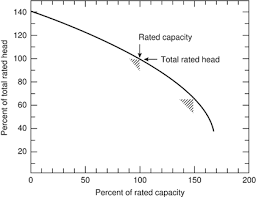
The image above represents the capacity of the sprinkler system. You need four essential parameters to calculate the capacity of the sprinkler system. They are: Area to be Irrigated (A), Net Depth of Water Application (d), Number of Drops allowed for the Completion of One Irrigation (F), Number of Actual Operating Hours per Day (H), and Water Application Efficiency (E).
The formula for calculating capacity of the sprinkler system:
Q = 27800 . A . d / F . H . E
Where:
Q = Capacity of the Sprinkler System
A = Area to be Irrigated
d = Net Depth of Water Application
F = Number of Drop allowed for the Completion of One Irrigation
H = Number of Actual Operating Hours per Day
E = Water Application Efficiency
Let’s solve an example;
Find the capacity of the sprinkler system when the area to be irrigated is 2, the net depth of water application is 8, the number of drop allowed for the completion of one irrigation is 10, the number of actual operating hours per day is 6 and the water application efficiency is 4.
Hence, this implies that;
A = Area to be Irrigated = 2
d = Net Depth of Water Application = 8
F = Number of Drop allowed for the Completion of One Irrigation = 10
H = Number of Actual Operating Hours per Day = 6
And then E = Water Application Efficiency = 4
Q = 27800 . A . d / F . H . E
Q = 27800 . (2) . (8) / (10) . (6) . (4)
That is, Q = 444800 / 240
Q = 1853.3
Therefore, the capacity of the sprinkler system is 1853.3.
Calculate the Area to be Irrigated when the Capacity of the Sprinkler System, the Net Depth of Water Application, the Number of drop Allowed for the Completion of One Irrgiation, the Number of Actual Operating Hours per Day and the Water Application Efficiency are Given
A = Q x F . H . E / 27800 . d
Where the following applies:
A = Area to be Irrigated
Q = Capacity of the Sprinkler System
d = Net Depth of Water Application
F = Number of Drop allowed for the Completion of One Irrigation
H = Number of Actual Operating Hours per Day
And then, E = Water Application Efficiency
So, let’s Solve an example;
Find the area to be irrigated when the capacity of the sprinkler system is 4, the net depth of water application is 6, a number of drops allowed for the completion of one irrigation is 2, a number of actual operating hours per day is 3, and the water application efficiency is 8.
This implies that;
Q = Capacity of the Sprinkler System = 4
d = Net Depth of Water Application = 6
F = Number of Drop allowed for the Completion of One Irrigation = 2
H = Number of Actual Operating Hours per Day = 3
And then, E = Water Application Efficiency = 8
A = Q x F . H . E / 27800 . d
A = 4 x 2 . 3 . 8 / 27800 . 6
Then, A = 192 / 166800
A = 0.00115
Therefore., the area to be irrigated is 0.00115.
Calculating for the Net Depth of Water Application when the Capacity of the Sprinkler System, the Area to be Irrigated, the Number of drop Allowed for the Completion of One Irrgiation, the Number of Actual Operating Hours per Day and the Water Application Efficiency are Given
d = Q x F . H . E / 27800 . A
Where the following:
d = Net Depth of Water Application
Q = Capacity of the Sprinkler System
A = Area to be Irrigated
F = Number of Drop allowed for the Completion of One Irrigation
H = Number of Actual Operating Hours per Day
And then, E = Water Application Efficiency
So, let’s Solve an example;
Find the net depth of water application when the capacity of the sprinkler is 8, the area to be irrigated is 2, number of drops allowed for the completion of one irrigation is 4, the number of actual operating hours per day is 9 and the water application efficiency is 7.
Hence, this implies that;
Q = Capacity of the Sprinkler System = 8
A = Area to be Irrigated = 2
F = Number of Drop allowed for the Completion of One Irrigation = 4
H = Number of Actual Operating Hours per Day = 9
And then, E = Water Application Efficiency = 7
d = Q x F . H . E / 27800 . A
d = 8 x 4 . 9 . 7 / 27800 . 2
Then, d = 2016 / 55600
d = 0.036
Therefore, the net depth of water application is 0.036.
Calculating the Number of drops Allowed for the Completion of One Irrigation when the Capacity of the Sprinkler System, the Net Depth of Water Application, the Area to be Irrigated, the Number of Actual Operating Hours per Day, and the Water Application Efficiency are Given.
F = 27800 . A . d / Q x H . E
Where the following applies:
F = Number of Drop allowed for the Completion of One Irrigation
Q = Capacity of the Sprinkler System
A = Area to be Irrigated
d = Net Depth of Water Application
H = Number of Actual Operating Hours per Day
And then, E = Water Application Efficiency
Master Calculations Instantly
Unlock solutions for math, physics, engineering, and chemistry problem with step-by-step clarity. No internet required. Just knowledge at your fingertips, anytime, anywhere.
So, let’s Solve an example;
Calculate the number of drops permitted to complete one irrigation when the sprinkler’s capacity is 12, the area to be irrigated is 3, the net depth of water application is 4, there are 10 actual operating hours per day, and the water application efficiency is 8.
Hence, this implies that;
Q = Capacity of the Sprinkler System = 12
A = Area to be Irrigated = 3
d = Net Depth of Water Application = 4
H = Number of Actual Operating Hours per Day = 10
And then, E = Water Application Efficiency = 8
F = 27800 . A . d / Q x H . E
So, F = 27800 . 3 . 4 / 12 x 10 . 8
F = 333600 / 960
F = 347.5
Therefore, the number of drops allowed for the completion of one irrigation is 347.5.
Calculating the Number of Actual Operating Hours per Day when the Capacity of the Sprinkler System, the Net Depth of Water Application, the Area to be Irrigated, the Number of drops Allowed for the Completion of One Irrigation and the Water Application Efficiency are Given
H = 27800 . A . d / Q x F . E
Where the following applies:
H = Number of Actual Operating Hours per Day
Q = Capacity of the Sprinkler System
A = Area to be Irrigated
d = Net Depth of Water Application
F = Number of Drop allowed for the Completion of One Irrigation
E = Water Application Efficiency
Let’s Solve an example;
Find the number of actual operating hours per day when the capacity of the sprinkler system is 24, the area to be irrigated is 6, the net depth of water application is 8, the number of drops allowed for the completion of one irrigation is 30, and the water application efficiency is 18.
This implies that;
Q = Capacity of the Sprinkler System = 24
A = Area to be Irrigated = 6
d = Net Depth of Water Application = 8
F = Number of Drop allowed for the Completion of One Irrigation = 30
E = Water Application Efficiency = 18
H = 27800 . A . d / Q x F . E
H = 27800 . 6 . 8 / 24 x 30 . 18
That is, H = 1334400 / 12960
H = 102.96
Therefore, the number of actual operating hours per day is 102.96.
Read more: How to Calculate and Solve for Inflow Time (Net Application Depth) | Irrigation Water Requirement
Calculating for the Water Application Efficiency when the Capacity of the Sprinkler System, the Net Depth of Water Application, the Area to be Irrigated, the Number of drop Allowed for the Completion of One Irrgiation and the Number of Actual Operating Hours per Daya are Given
E = 27800 . A . d / Q x F . H
Where;
E = Water Application Efficiency
Q = Capacity of the Sprinkler System
A = Area to be Irrigated
d = Net Depth of Water Application
F = Number of Drop allowed for the Completion of One Irrigation
H = Number of Actual Operating Hours per Day
Let’s Solve an example;
Find the water application efficiency when the capacity of the sprinkler system is 32, the area to be irrigated is 5, the net depth of water application is 2, the number of drop allowed for the completion of one irrigation is 28 and the number of actual operating hours per day is 22.
This implies that;
Q = Capacity of the Sprinkler System = 32
A = Area to be Irrigated = 5
d = Net Depth of Water Application = 2
F = Number of Drop allowed for the Completion of One Irrigation = 28
H = Number of Actual Operating Hours per Day = 22
E = 27800 . A . d / Q x F . H
E = 27800 . 5 . 2 / 32 x 28 . 22
So, E = 278000 / 19712
E = 14.10
Therefore, the water application efficiency is 14.10.
How to Calculate Capacity of the Sprinkler System With Nickzom Calculator
Nickzom Calculator – The Calculator Encyclopedia is capable of calculating the capacity of the sprinkler system.
To get the answer and workings of the capacity of the sprinkler system using the Nickzom Calculator – The Calculator Encyclopedia. First, you need to obtain the app.
You can get this app via any of these means:
Web – https://www.nickzom.org/calculator-plus
To get access to the professional version via web, you need to register and subscribe for NGN 2,000 per annum to have utter access to all functionalities.
You can also try the demo version via https://www.nickzom.org/calculator
Android (Paid) – https://play.google.com/store/apps/details?id=org.nickzom.nickzomcalculator
Android (Free) – https://play.google.com/store/apps/details?id=com.nickzom.nickzomcalculator
Apple (Paid) – https://itunes.apple.com/us/app/nickzom-calculator/id1331162702?mt=8
Once you have obtained the calculator encyclopedia app, proceed to the Calculator Map, then click on Agricultural under Engineering.
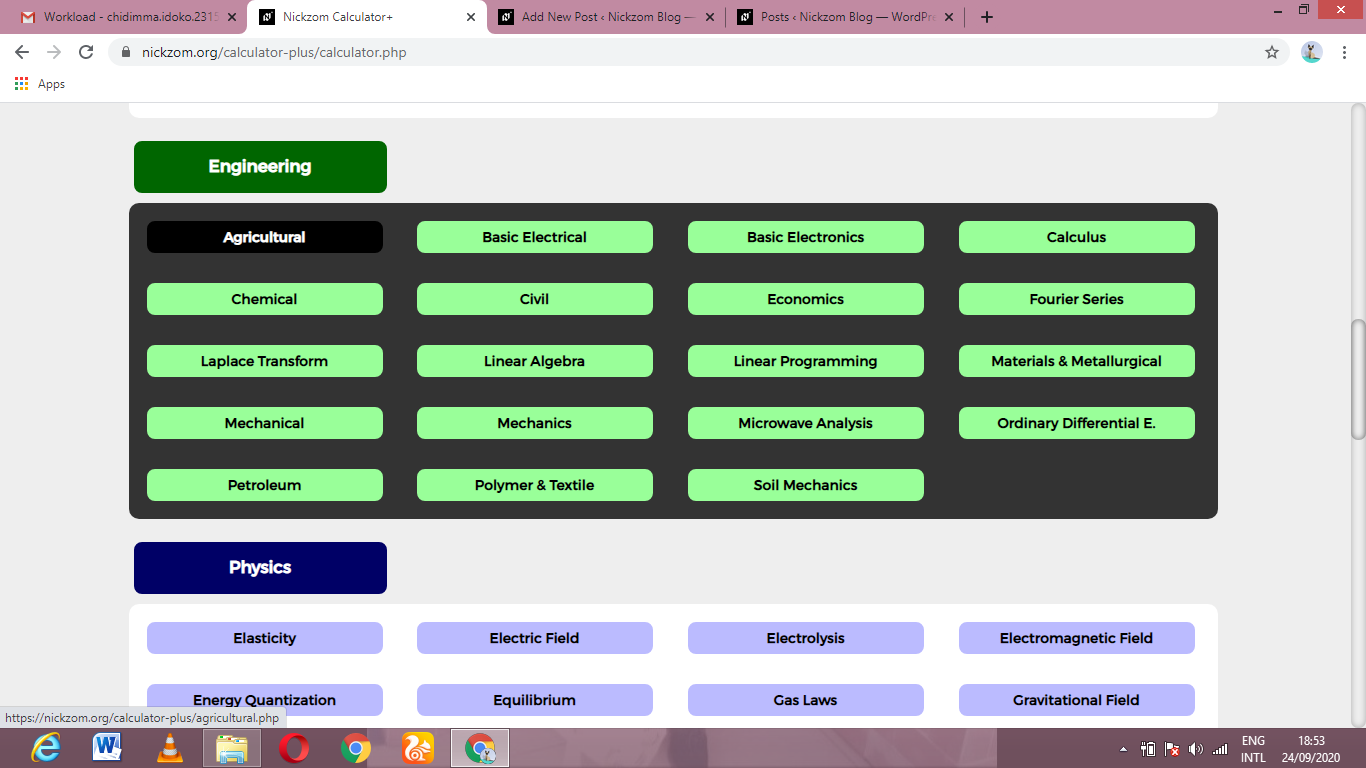
Now, Click on Irrigation Water Requirement under Agricultural
Master Calculations Instantly
Unlock solutions for math, physics, engineering, and chemistry problem with step-by-step clarity. No internet required. Just knowledge at your fingertips, anytime, anywhere.
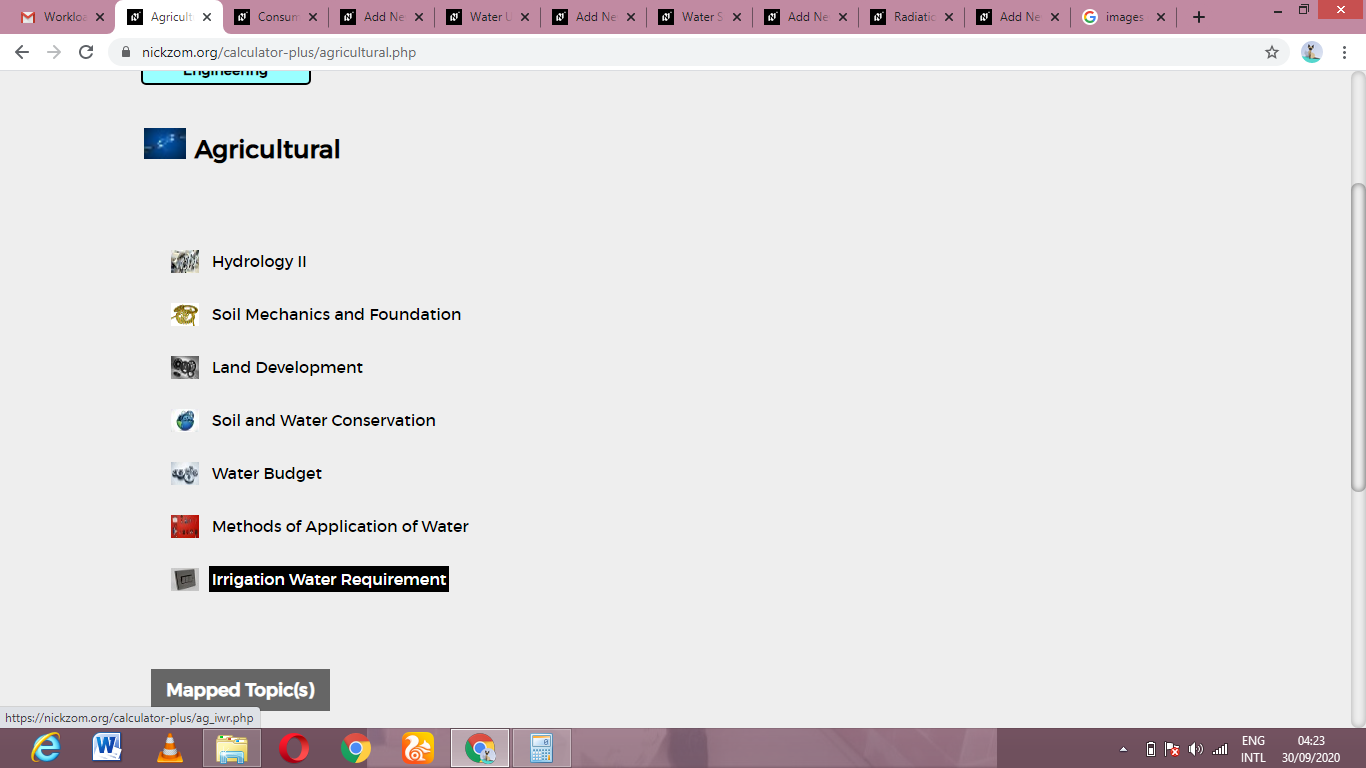
Now, Click on Capacity of the Sprinkler System under Irrigation Water Requirement
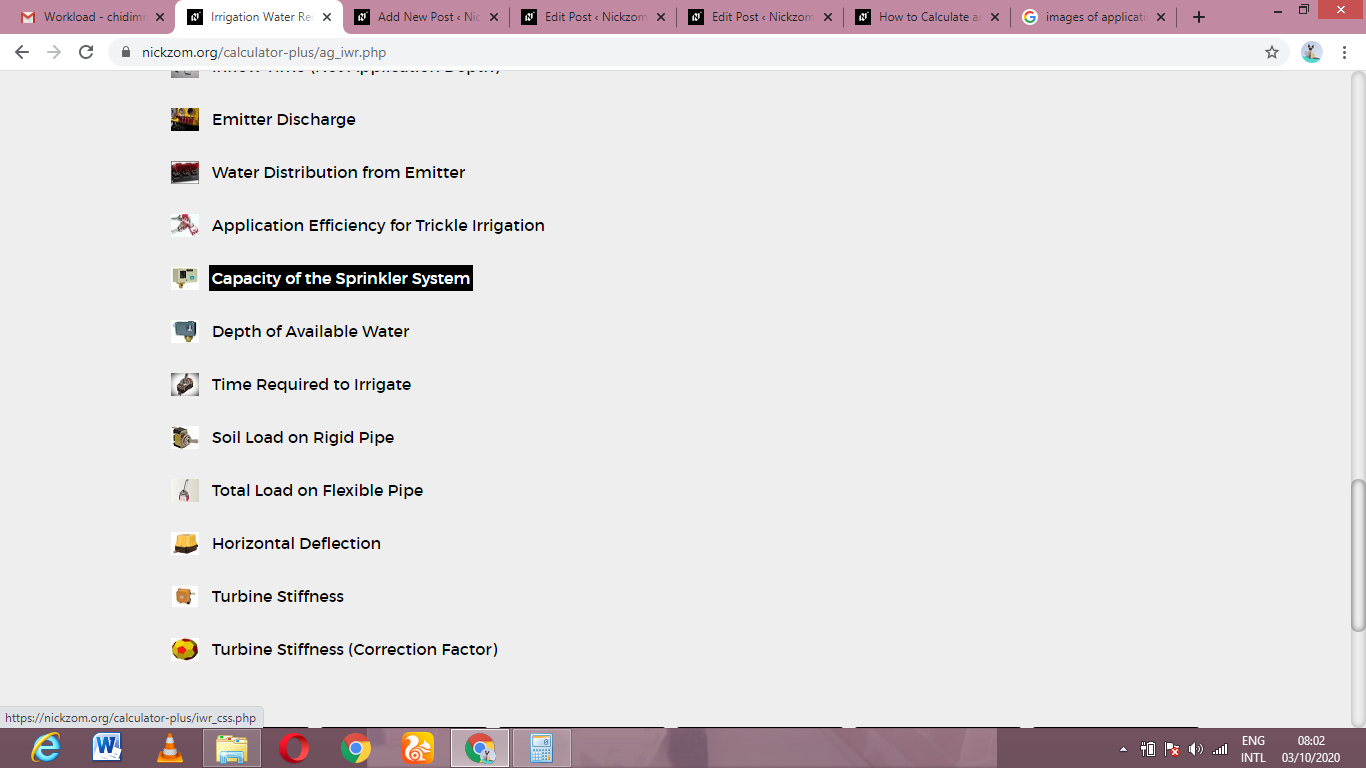
Below is the screenshot showing the page or activity where you enter your values to calculate the sprinkler system’s capacity. This is based on the following parameters: Area to be Irrigated (A), Net Depth of Water Application (d), Number of Drops allowed for the Completion of One Irrigation (F), Number of Actual Operating Hours per Day (H), and Water Application Efficiency (E).
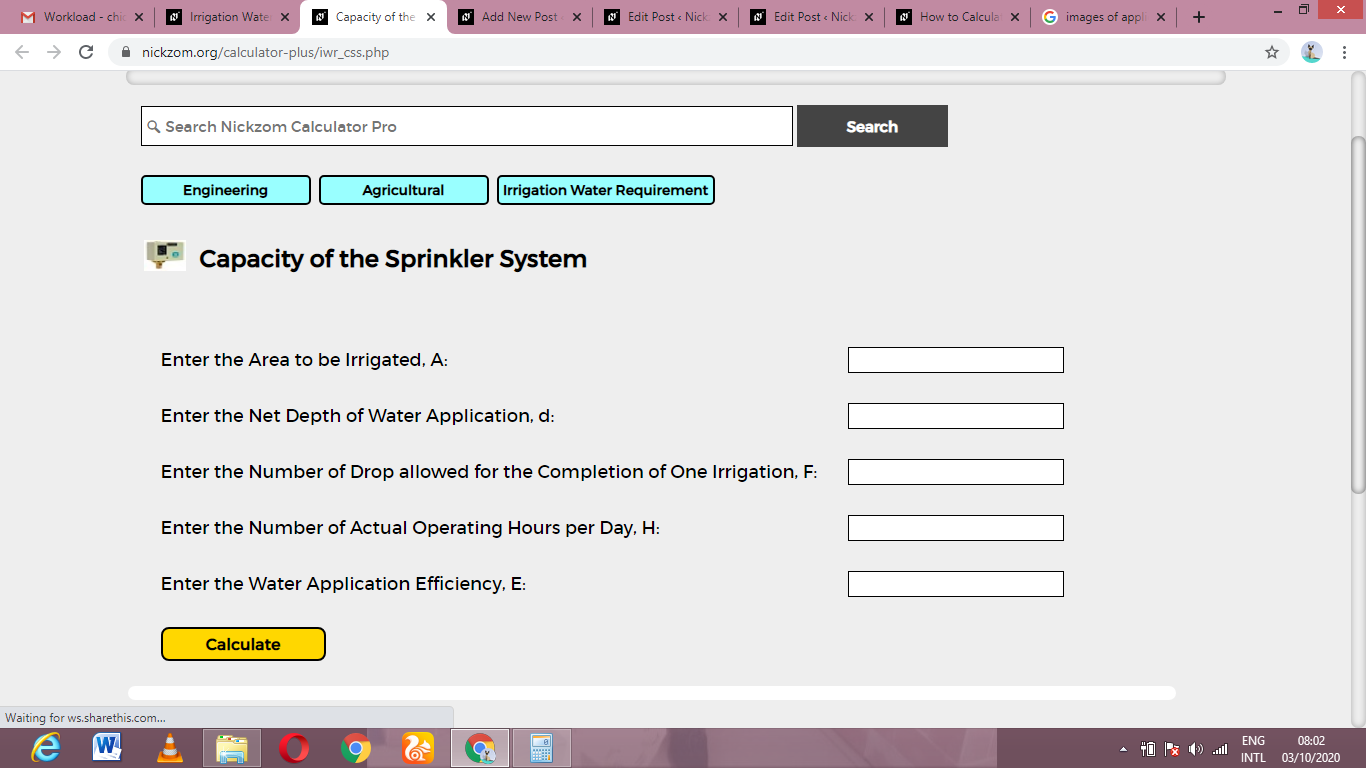
Enter the appropriate values for the parameters required by the area to be irrigated (A), which is 2; the net depth of water application (d), which is 8; the number of drops allowed for the completion of one irrigation (F), which is 10; the number of actual operating hours per day (H), which is 6; and the water application efficiency (E), which is 4.
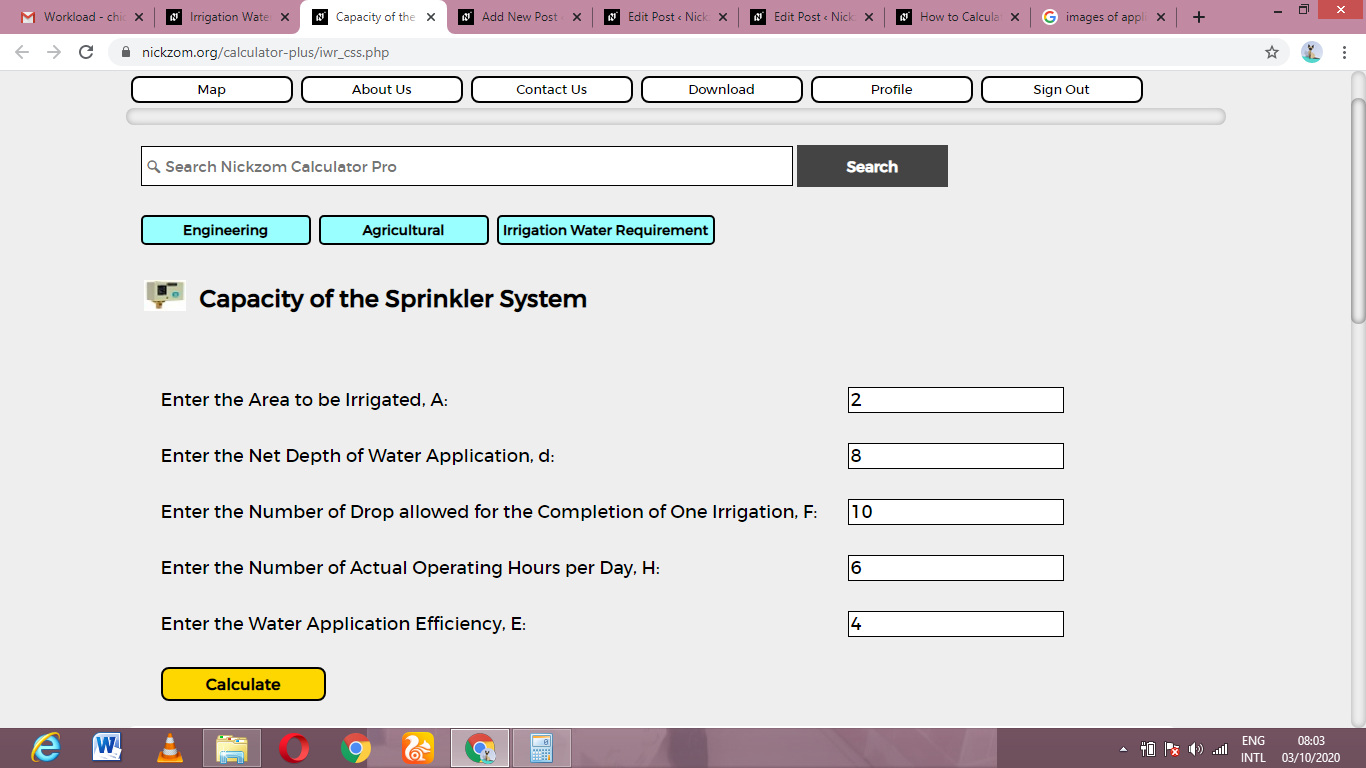
Finally, Click on Calculate
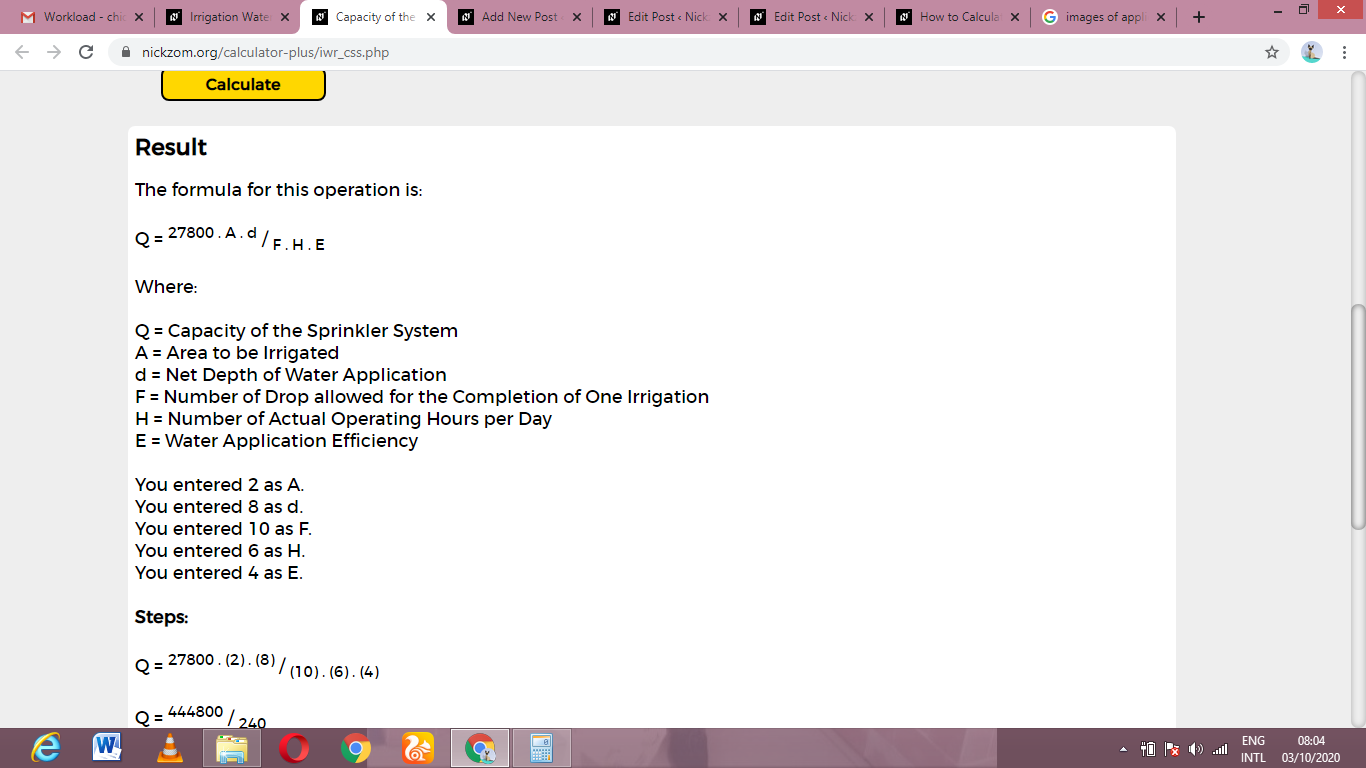
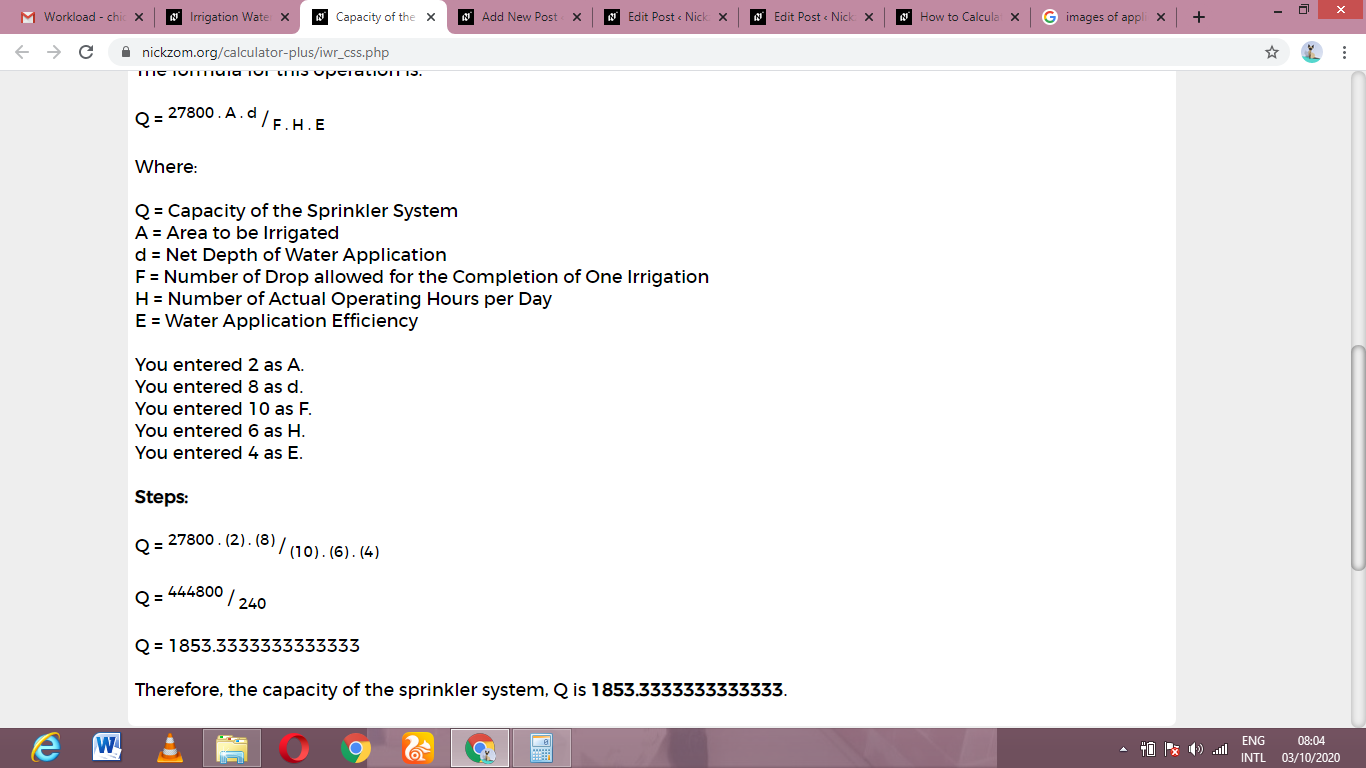
As you can see from the screenshot above, Nickzom Calculator– The Calculator Encyclopedia solves for the capacity of the sprinkler system and presents the formula, workings, and steps, too.



